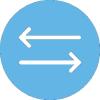Health IT
Health IT Basics
Health information technology (health IT) is upgrading health care to the 21st century by giving providers and patients access to information when and where it is needed most. This three-minute video, created by the Office of the National Coordinator for Health IT (ONC), gives a great overview of how new technologies can help improve your health care:
Types of Health IT
Choose from an area below to learn more about a different type of health IT:
Electronic Health Record (EHR)
Electronic systems that collect, share, and use patient health information (e.g., Epic)
Health Information Exchange (HIE)
The movement of patient health information electronically to better coordinate care (e.g., WISHIN)
Patient Portals
A secure website that gives patients convenient 24-hour access to personal health information from anywhere with an internet connection (e.g., MyChart, My HealtheVet)
Public Health Registries and Clinical Data Registries
Entities that collect public health or clinical data for the purpose of patient, disease, and population health tracking to foster quality improvement (e.g., Wisconsin Immunization Registry, Prescription Drug Monitoring Program)
Telehealth
The use of electronic information and telecommunications technologies (like live videoconferencing) to supports long-distance clinical health care (like eVisits) and patient and professional health-related education (e.g., Smartphone apps, smart blood glucose monitors)
Electronic Prescribing
Fast, easy way to write and/or reorder and transmit prescriptions electronically using EHR technology (e.g., Surescripts)
These are some of the more common technologies in the health IT tool kit—and they can be used for health IT-enabled delivery of care.
Source: ONC, Patients and Families
Benefits of Health IT
New technologies can change our relationship with the organizations we rely on. Today, services like online banking and streaming entertainment have changed how we manage money and consume media.
Much like the banking and entertainment industries, health IT is transforming the way we access and engage with health care. Health IT (like eVisits and patient portals) provides many advantages for health care professionals, consumers, patients, and families.
The benefits of health IT are exciting because they show a promise for driving improved outcomes in the delivery of health care. And these benefits are enhanced by "interoperable" health IT—tools that can seamlessly exchange and use information. Much like a banking application on a smartphone recognizes a cup of coffee was recently purchased with a debit card, so too can a patient portal recognize health care services were recently administered and provide a summary of that information to an individual's fingertips.
Overall, the value of health IT is maximized when a health care provider or individual can access and use their health information electronically, when and where they need it most. Read below for examples of how health IT can benefit health care professionals and individuals/patients:
Generally, health IT can benefit health care professionals by:
- Increasing the availability and timeliness of health information for the delivery of quality care.
- Enhancing decision support tools for patient safety.
- Centralizing communications with patients (and other providers) about anything from updated care plans to new prescriptions.
The use of health IT to seamlessly exchange and interpret shared health information (or interoperable health IT) can impact and improve the overall health of Wisconsinites by creating efficiencies and supporting the comprehensive delivery of care.
Generally, health IT can benefit health care consumers by:
- Providing remote access to care or a more accurate health histories at the provider’s office.
- Improving care coordination among specialists and reducing unnecessary tests.
- Helping track personal health and wellness goals.
Within health care, the individual is often a recipient of services rather than an active partner with the health care providers and care team. This dynamic can limit the opportunities for individuals to manage their own health and share in care management. Health IT can be used to help support a "person-centered" health care system where individuals are empowered to use wellness and health care services enabled by technology to improve health and health care outcomes.
Source: ONC, Benefits of Health IT
Have a question? Send us an email at eHealth@wi.gov.








